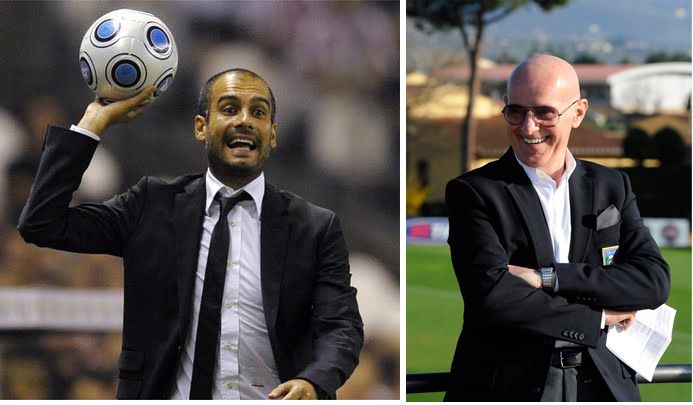
Pep's Barcelona vs Sacchi's Milan - Clash of the titans
Pep Guardiola has re-invented football so much in the past three years that one wonders if the game is still the same that was played in the last two decades. ‘Total Football’ – as some may put it, is slowly becoming the new face of football in the new decade, as specialists find themselves out of the limelight. Defenders who can play anywhere across the backline, midfielders who can play in defense, forwards who play as midfielders, central midfielders who play as wingers, and the best player in the world who can play as a right forward or a false 9 – you name it, they have it all.
The last definitive shift in tactics in football occurred back in the late 80s, when Arrigo Sacchi, the master tactician from Italy decided that a change was required from the five-man backline or the sweeper formation to a four-man backline, which depends more on the offside trap than sheer defensive prowess. While it was Italy’s domination of Europe in the 60s which made the sweeper-formation famous, it was Milan’s domination in the late 80s – early 90s which brought an end to it.
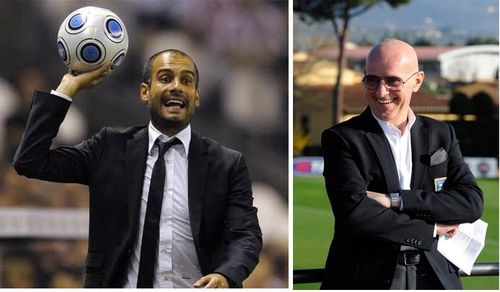
Changing the rules, changing the game
While Josep Guardiola and his star-studded team clearly has a shout at being the greatest club team of all time, Arrigo Sacchi’s Milan stands in their way, paving way for doubts. Hence the need for an in-depth analysis of the two teams, and how they would fare against each other. But is is very important to remember, as Jose Mourinho said,
“To be the ultimate team, you must use your body and your mind. Draw up on the resources of your teammates. Choose your steps wisely and you will win. Remember, only teams succeed.”
Change in football, level of competition and honours
There have been a couple of rule changes in football over the period of time. Hence, it is important to take them into account before we proceed further. The major rule changes are:
- Offside rule: During the time of Sacchi’s Milan, any player behind the defensive line was termed offside, even if he was not interfering with the play. There was no difference between an active offside and a passive offside.
- Ball change: Back in early 90s, the whole match was played with a single ball. So, the teams would have to wait till the ball is fetched back to resume play. This gave teams enough time to regroup, especially if they were coming under waves after waves of attack.
- Material of the ball: The new material makes for better attacking, and makes it tough for the goalkeeper to judge the trajectory due to improved aerodynamics.
- Level of refereeing: The level of refereeing today is more strict compared to Sacchi’s era. It would be hard for the hard tacklers of Milan to play an entire game against a highly technical side without getting booked.
- Finally, back in the early 90s, the game in itself was very physical and demanded a lot of strength and stamina to work through the entire 90 minutes. Today’s game is dependent more on technical aspects of the game.
Pep Guardiola’s Barcelona team won La Liga thrice and the European Cup twice in three seasons – quite an astounding feat. They also won the domestic cup once and the Club World Cup twice, apart from two UEFA Super Cups and two Spanish Supercopas. In comparison, Arrigo Sacchi’s Milan won back-to-back European Cups, but have won the Serie A just once, finishing runners-up twice. They also managed to win two UEFA Super Cups and two Intercontinental Cups.
Comparing the teams based on the level of competition, it has to be said that Sacchi’s Milan played in the most competitive era of Serie A. They had to compete with Maradona’s Napoli, Inter with Brehme, Matthaus, Bergomi and Klinsmann, Roma with Rudi Voller, Gianluca Vialli’s Sampdoria and Juventus coached by Dino Zoff amongst others. Barcelona, in comparison has only Real Madrid to give them any real competition in La Liga.
Teams on paper – Player to player comparison
Before we start discussing tactics, it is important to see how the players of both the teams compare against each other in their respective areas. Though this has little bearing on the final results, it helps one identify if a team would dominate a particular area on the field, thus making further analyses easier. The complete teams and formations are as given below:
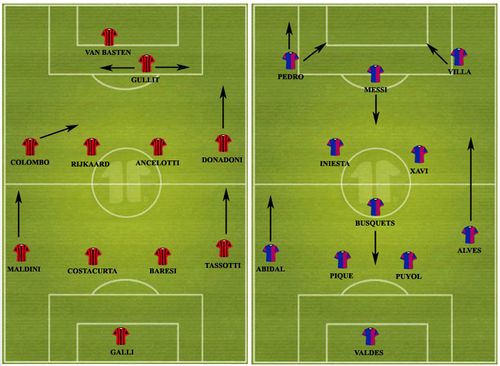
AC Milan and Barca formations (Click to enlarge)
AC Milan : Giovanni Galli, Paolo Maldini, Alessandro Costacurta, Franco Baresi, Mauro Tassotti, Angelo Colombo, Frank Rijkaard, Carlo Ancelotti, Roberto Donadoni, Ruud Gullit, Marco van Basten
Barcelona : Victor Valdes, Eric Abidal, Gerard Pique, Carles Puyol, Daniel Alves, Sergi Busquets, Xavi, Andres Iniesta, Pedro, Lionel Messi, David Villa.
(It should be noted that Alexis Sanchez plays in the position of Pedro or Villa and/or Fabregas plays on the right, if and when they play).
The only player who isn’t mentioned repeatedly in the Milan side, and rightly so is the Italian goalkeeper Giovanni Galli. While he was reasonably solid and reliable at the back, he does not compare well with Victor Valdes, who has been phenomenal for Los Cules. Valdes also has the advantage of being good on the ball, and is well capable of starting attacks from the back, much like a sweeper-keeper.
There is no real comparison in the defense, as the legendary Milan back four of Maldini – Costacurta – Baresi – Tassotti is one of the greatest and the most balanced back line of all times. In comparison, Abidal – Pique – Puyol – Alves comes a step down, if not two. Maldini, Baresi and Costacurta are better than their counterparts in almost all aspects of the game, and while Alves is great going forward, Tassotti is a better all-round full back.
The game changes on its head in the midfield, as Busquets – Xavi – Iniesta form an enviable trio which controls the game at will and pulls all the strings. As good as Rijkaard and Ancelotti were, they will find it difficult to subdue the highly technical Barca midfield, even with Colombo tucked in from the left to support the Milan midfield.
Roberto Donandoni can only be compared to Pedro, who is the only genuine width-provider in the Barca front-line, and it can be arguably said that Donadoni is the better player in comparison. There isn’t much to choose in attack, as Marco van Basten and Gullit form a deadly pair up front for Milan, while the front three of Villa – Messi – Pedro/Sanchez is one of the best forward line of their generation. Subjectively speaking, though, it can be argued that since van Basten and Gullit had to face much tougher defenses during their times, they were better. But one cannot simply rule out a forward line that produces close to 100 goals season after season.
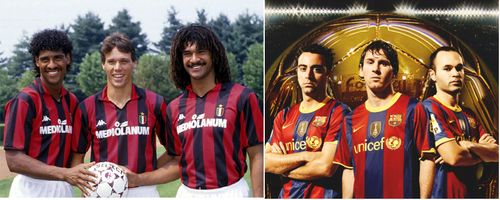
The masters of the game
Talking Tactics
One cannot help but marvel at how the two teams are so similar in essence yet so different in execution. Arrigo Sacchi and Pep Guardiola – both gave a lot of importance to team work and movement off the ball. Both Milan and Barcelona attack as a team, and defend as a team. They do not rely on a few players to win them games, though both the teams have a trio on whom their game is based. In case of Milan, the game flows through the Dutch trio of Rijkaard – Gullit – van Basten, and in case of Barcelona, it is the homegrown trinity of Xavi – Iniesta – Messi. Both the teams build up their attack from the back, and both the teams have an inspirational, legendary figure at the back marshalling their defenses.
While Barcelona thrives on exploiting spaces on the field, Milan worked by creating them. While Pep Guardiola has advocated ‘Total Football’ – one where every player can fill in for another, and the game progresses by constant interchange of positions, Sacchi’s teams almost always finished the game the way they started. It is, in essence, a match between two teams – one fluid and expressive, and the other, quite rigid in comparison. While Barcelona prefers to play it narrow, with only their full backs providing width on most occasions, Milan are a side that mastered the classic 4-4-2, playing it wide and working the ball in. Barca prefers to keep the ball on the ground, thus negating their height disadvantage, while Milan could easily play an aerial game, with Gullit, van Basten and Rijkaard winning most of the headers they attempt.
Ever since Cesc Fabregas has joined Barcelona, they have added a new dimension to their tactics, as shown below. It allows for greater interchange between the midfielders, as Cesc is capable of playing on the right, and so is Iniesta on the left.
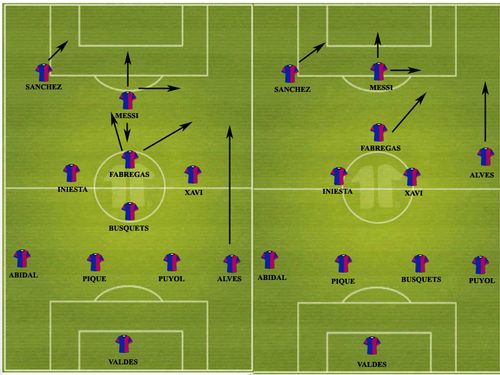
Total Football (Click to enlarge)
It should be noted how Busquets drops deep to play as an auxiliary CB, while Alves acts as a winger, with Puyol back to his early role as a right back. The following picture shows the heat maps of various FC Barcelona players during the Champions League 2010-11 Final against Manchester United.
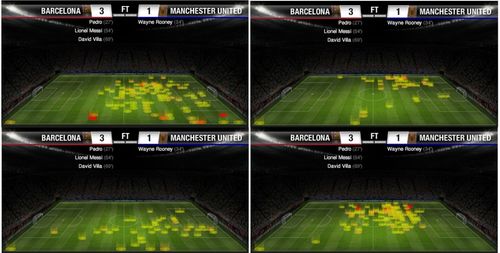
Heat maps of Messi, Pedro, Villa and Iniesta (Click to enlarge)
It can be seen how the wing forwards interchange and Lionel Messi acts as a False 9 – in essence, a forward playmaker in addition to being a striker.
In comparison, it is worth noting how Milan played their link up game. Ruud Gullit drops deep and links up with Rijkaard and Ancelotti creating a negative space, wherein he draws the defenders to himself, opening up large spaces for Donadoni and Marco van Basten to glide into. Colombo, on his part, moves inside, enticing the defender marking him to show him on to his weaker side. The move finds Ancelotti on the inside left position ready to bomb forward, while Colombo moves into the midfield. But the most important aspect of the Milan game play is that, in spite of all the player movement, they always return to their respective positions. And that is exactly what makes their game so effective – that the players could shift between the fluid and the rigid in the blink of an eye.
Walking the talk
Finally, it boils down to the match, and all the tactics and player comparison would be of little importance if not put into good use. It is not simple to bring up rule changes and style of play, as the managers and the players involved are tactically very aware and possess a high degree of adaptability. The match, in itself, will be fought in two regions – Barca forward line vs Milan’s defense and the midfield battle.
The key battle will be between Messi and Baresi. Messi, in his illustrious career, has never come across a man marker quite like Franco Baresi. Add to the fact that Barca have always struggled against disciplined quality defenses, the battle may well swing in favour of the Italian. If anything, it is only fair to assume that the Milan defense would do a better job compared to Jose Mourinho’s Inter against Barcelona. Baresi would also call out for the defense to push forward and work the offside trap whenever a player got behind them. This would push the Barca front line back into the midfield, which in turn, adds more numbers to the Barca midfield.
Barcelona will dominate the midfield, even with the ever-present pair of Rijkaard and Ancelotti. The technical finesse of Xavi and Iniesta, with the highly underrated Busquets to support them, will see a lot of chances being created for the forwards. But the Milan defense, being made of the stalwarts that they are, will snuff out most of them. On the contrary, Milan will depend on their wide players to create most of their chances, catching Barcelona off-guard with their pace and aerial advantage. Donadoni and Colombo are more than capable of switching flanks at will, confusing the opposition defenders. Gullit’s physicality will come into play against the sturdy centre backs of Catalunya, and van Basten’s precision will be a huge test for Victor Valdes. But the pace and recovery rate of Carles Puyol and the game-reading abilities of Gerard Pique will ensure that the Dutch duo do not get as many chances as usual.
The average positions of the players at the end of the match, would be as given below.
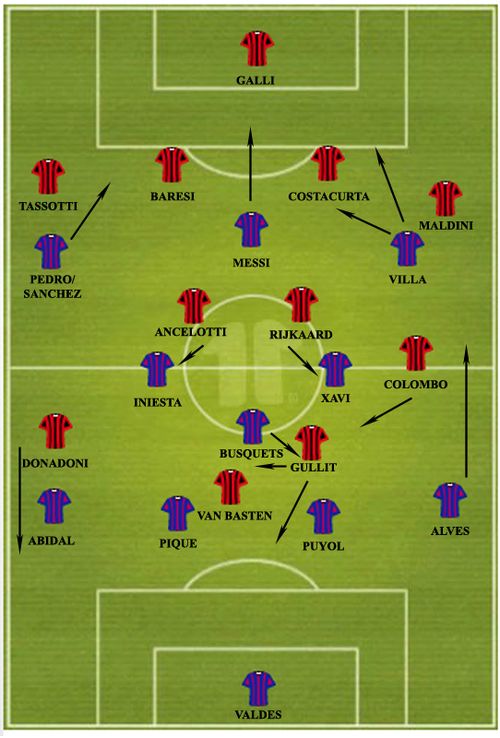
Average positions (Click to enlarge)
In the end, it will come down to the few magical moments that will change the game on its head, as both teams are almost evenly matched. And what Barca lacks in terms of player quality, they make up for it in terms of their movement and passing. While Messi and Iniesta will decide the final goal tally for Barcelona, Gullit, van Basten and the industrious midfield behind them will ensure that Milan are an equal match, if not the better side. While Barcelona will dominate the play for most of the match, Milan will look to play on the counter, and make the most of whatever chances they create. Milan will win the match narrowly, only by virtue of having a better defense.
Final score: AC Milan 2-1 FC Barcelona
Let us know if you liked the analysis. Please share it with your equally football – crazy friends, and spread the word. Read some more tactics-heavy articles here:
- Football Tactics: Emergence of ‘Micro Tactics’ and the Changing Face of Football
- Of Wines and Winners In Football, Legends and Longevity